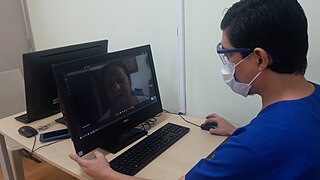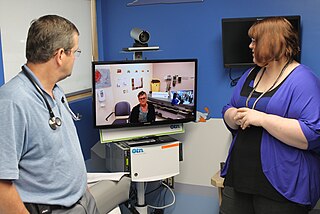
Telehealth is the distribution of health-related services and information via electronic information and telecommunication technologies. It allows long-distance patient and clinician contact, care, advice, reminders, education, intervention, monitoring, and remote admissions. Telemedicine is sometimes used as a synonym, or is used in a more limited sense to describe remote clinical services, such as diagnosis and monitoring. When rural settings, lack of transport, a lack of mobility, conditions due to outbreaks, epidemics or pandemics, decreased funding, or a lack of staff restrict access to care, telehealth may bridge the gap as well as provide distance-learning; meetings, supervision, and presentations between practitioners; online information and health data management and healthcare system integration. Telehealth could include two clinicians discussing a case over video conference; a robotic surgery occurring through remote access; physical therapy done via digital monitoring instruments, live feed and application combinations; tests being forwarded between facilities for interpretation by a higher specialist; home monitoring through continuous sending of patient health data; client to practitioner online conference; or even videophone interpretation during a consult.

Telenursing refers to the use of information technology in the provision of nursing services whenever physical distance exists between patient and nurse, or between any number of nurses. As a field, it is part of telemedicine, and has many points of contacts with other medical and non-medical applications, such as telediagnosis, teleconsultation, and telemonitoring. The field, however, is still being developed as the information on telenursing isn't comprehensive enough.

UC Davis Medical Center is part of UC Davis Health and a major academic health center located in Sacramento, California. It is owned and operated by the University of California as part of its University of California, Davis campus. The medical center sits on a 142-acre (57 ha) campus located between the Elmhurst, Tahoe Park, and Oak Park residential neighborhoods. The site incorporates the land and some of the buildings of the former Sacramento Medical Center as well as much of the land previously occupied by the California State Fair until its 1967 move to a new location.
Home automation for the elderly and disabled focuses on making it possible for older adults and people with disabilities to remain at home, safe and comfortable. Home automation is becoming a viable option for older adults and people with disabilities who would prefer to stay in the comfort of their homes rather than move to a healthcare facility. This field uses much of the same technology and equipment as home automation for security, entertainment, and energy conservation but tailors it towards old people and people with disabilities.

The University of New Mexico Hospital is a public teaching hospital located in Albuquerque, New Mexico, immediately north of the main campus of the University of New Mexico. The hospital is the only Level I trauma center in the state of New Mexico, and also houses the only certified burn unit and designated stroke center in the state. In addition, UNMH also contains the only children's hospital in New Mexico, and is the state's sole source of 13 pediatric sub-specialties. As a safety net hospital, UNMH serves a large percentage of the uninsured and under-insured population of the state. The hospital is the main teaching facility for the University of New Mexico School of Medicine.
Banner Health is a non-profit health system in the United States, based in Phoenix, Arizona. It operates 30 hospitals and several specialized facilities across 6 states. The health system is the largest employer in Arizona and one of the largest in the United States with over 50,000 employees.
Connected health is a socio-technical model for healthcare management and delivery by using technology to provide healthcare services remotely. Connected health, also known as technology enabled care (TEC) aims to maximize healthcare resources and provide increased, flexible opportunities for consumers to engage with clinicians and better self-manage their care. It uses readily available consumer technologies to deliver patient care outside of the hospital or doctor's office. Connected health encompasses programs in telehealth, remote care and disease and lifestyle management, often leverages existing technologies such as connected devices using cellular networks and is associated with efforts to improve chronic care. However, there is an increasing blur between software capabilities and healthcare needs whereby technologists are now providing the solutions to support consumer wellness and provide the connectivity between patient data, information and decisions. This calls for new techniques to guide Connected Health solutions such as "design thinking" to support software developers in clearly identifying healthcare requirements, and extend and enrich traditional software requirements gathering techniques.
CareCloud, Inc. is a publicly traded American healthcare information technology company that provides services, to healthcare providers and hospitals throughout the United States. The Company maintains its headquarters in Somerset, New Jersey and employs approximately 3,500 workers worldwide.
Doximity is an online networking service for medical professionals. Launched in 2010, the platform offers its members curated medical news, telehealth tools, and case collaboration.
Digital health is a discipline that includes digital care programs, technologies with health, healthcare, living, and society to enhance the efficiency of healthcare delivery and to make medicine more personalized and precise. It uses information and communication technologies to facilitate understanding of health problems and challenges faced by people receiving medical treatment and social prescribing in more personalised and precise ways.

Greenway Health, LLC is a privately-owned vendor of health information technology (HIT) including integrated electronic health record (EHR), practice management, and revenue cycle management solutions. Intergy, Greenway’s cloud-based EHR and practice management solution, serves ambulatory healthcare practices. The company has offices in Tampa, Florida; Carrollton, Georgia; and Bangalore, India.
Teladoc Health, Inc. is a multinational telemedicine and virtual healthcare company headquartered in the United States. Primary services include telehealth, medical opinions, AI and analytics, telehealth devices and licensable platform services. In particular, Teladoc Health uses telephone and videoconferencing software as well as mobile apps to provide on-demand remote medical care. Billed as the first and largest telemedicine company in the United States, Teladoc Health was launched in 2002 and has acquired companies such as BetterHelp in 2015, Best Doctors in 2017, and Advance Medical in 2018. It trades on the NYSE and in 2019 was active in 130 countries and served around 40 million members in 2021.
Ambra Health, is a software company that provides solutions for medical image sharing of DICOM and non-DICOM data between patients, physicians, and hospitals.
Mental health informatics is a branch of health or clinical informatics focused on the use of information technology (IT) and information to improve mental health. Like health informatics, mental health informatics is a multidisciplinary field that promotes care delivery, research and education as well as the technology and methodologies required to implement it.
e-consult is a mechanism developed by the Department of Veterans Affairs that enables primary care providers to obtain specialists' inputs into a patient's care treatment without requiring the patient to go to a face-to-face visit.
Hackensack Meridian Health (HMH) is a network of healthcare providers in New Jersey, based out of Edison. Members include academic centers, acute care facilities, and research hospitals. Hackensack Meridian Health's goal is to create one integrated network that changes how healthcare is delivered in New Jersey. The HMH network was formed in 2016 by a merger between Hackensack University Medical Center and Meridian Health. Hackensack Meridian Health is affiliated with the Hackensack Meridian School of Medicine and maintains active teaching programs at its hospitals. After the acquisition of JFK Medical Center in Edison, HMH is now the largest healthcare provider in New Jersey.
This list of telemedicine services providers is for notable telemedicine, telehealth, and mobile health providers and services. This includes virtual care facilities for remote care, services or platforms used for specific steps within the healthcare industry, and clinical navigation.
WELL Health Technologies is a multichannel digital health technology company and Canada’s largest owner and operator of outpatient health clinics. The company owns and operates primary healthcare facilities in Canada and The United States and also provides (SaaS) EMR services to clinics and doctors across Canada. Well Health Technologies is publicly traded on the Toronto Stock Exchange under the symbol WELL.TO. Hamed Shahbazi has served as the company's CEO since its foundation in 2010.

Carbon Health is an American chain of primary healthcare clinics that also provides telemedicine. It was founded in 2015 in San Francisco.

Telehealth is the practice of providing healthcare through online access methods such as through a smartphone, tablet, or computer. Telehealth is used to meet with a doctor live or patients can send messages through email or secure messaging. A doctor can also use remote monitoring to check on a patient at home. When the telehealth industry was first founded, it was primarily used to provide services to underserved and rural areas. Telehealth allowed people in these regions to be connected to specialists that were far away from them. Until recently, telehealth was predominately used for specialties such as cardiology, neurology, mental health, and dermatology. Telehealth has expanded to include many new applications such as physical therapy through digital monitoring tools and surgeries being done remotely by using robots. The telehealth industry started to become more developed in the early 2000s. The first major telehealth company, Teladoc, was founded in 2002 and since then the industry has grown to include companies such as Amwell, MeMD, and iCliniq.






